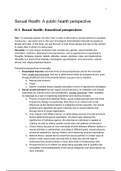Samenvatting
Summary book Sexual Health: A public health perspective
- Instelling
- Vrije Universiteit Amsterdam (VU)
Summary of the book 'Sexual health; a public health perspective'. The summary contains all important concepts and approaches in relation to sexual health. Examples are also given.
[Meer zien]





